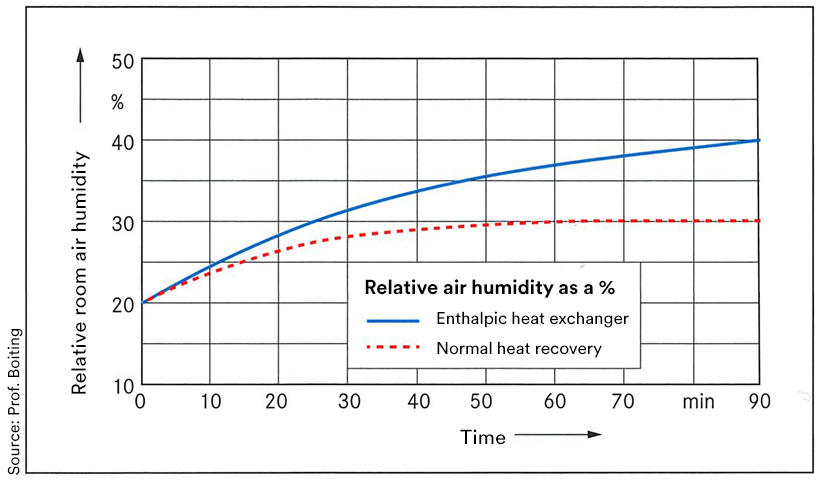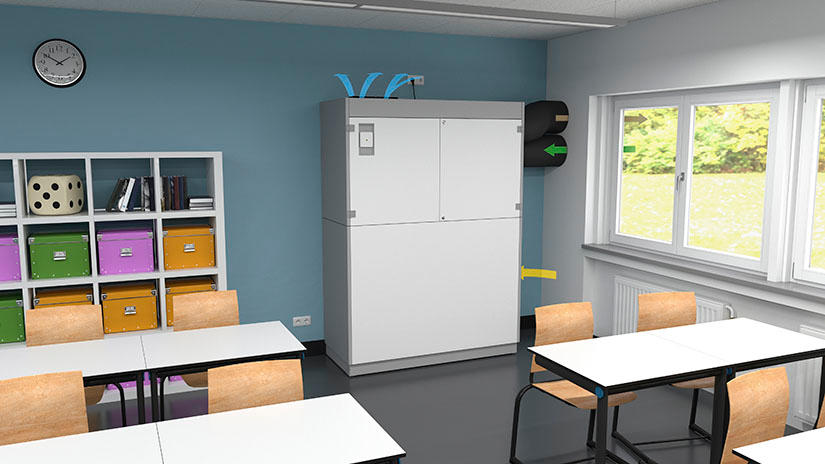Sensible air guidance and heat recovery systems for school classrooms under pandemic conditions
The Covid-19 pandemic has now clearly shown that schools are poorly prepared, if at all, for sustainable room ventilation. Tenders for retrofits are struggling to gain momentum. The need and the benefits have been known for some time. After all, pandemic-based ventilation is required to reduce the likelihood of infection through aerosols. This article deals with the air volumes required for this, the most appropriate methods of air guidance and the comfort aspects associated with this. And at the same time considering the room air humidity, particularly from an energy and health point of view.
The building services sector is in agreement that only systems with outside air supply and heat recovery are sustainable in terms of energy. On the one hand, they minimise the risk of disease transmission and also continuously reduce the concentration of CO2, which is known to cause fatigue, in an energy-efficient manner. The PIRA index is crucial when it comes to designing the right air volume to combat the risk of infection.
What does the PIRA value tell us?
BS EN 16798 Part 1 prescribes that the concentration of CO2 above a limit of 1,000 ppm in the room air must be diluted by a flow of outside air. This is often achieved by means of mixed ventilation. The Hermann-Ritschel Institute has developed an indicator that goes further than this to describe the risk of infection by SARS-CoV-2: the PIRA Index (Predicted Infection Risk for Aerosol Transmission of SARS-CoV-2/1/). The index is based on the answers to the following questions:
- How many polluted substances (aerosols) does a person suffering from SARS-CoV-2 exhale?
- How much of this can a healthy person inhale without becoming sick?
PIRA is thus the first index to look at the risk of infection, among other things in school classrooms. The value was set at 10 to ensure 90 % avoidance of transmission. Therefore, should there be a person carrying the disease in a room, then approx. 750 m3/h of unpolluted outside air or filtered recirculating air needs to be supplied to reduce the transmission of SARS-CoV-2 to other people in the room by 90 % for one hour.
What volume of outside air needs to be fed in for successful learning?
There are already design methods for ventilated rooms in the building service sector (based on the latest provisions of BS EN 16798 Part 1).
A typical classroom would need to be supplied with
- 1,000 m3/h of unpolluted outside air for a good room air quality (category II) or
- 550 m3/h of unpolluted outside air for an adequately good room air quality (category III).
DIN EN 16798-1 NA (Entwurf 06/2021) |
Kategorie II Volumenstrom |
Kategorie III Volumenstrom |
210 l/s |
120 l/s |
|
Floor area of the classroom = 80 m2 |
56 l/s |
32 l/s |
Total volumetric flow |
266 l/s = 957,6 m3/h |
152 l/s = 547,2 m3/h |
Prof. Dr.-Ing. Boiting from Münster University of Applied Sciences explains: “The values do not represent new findings. They roughly correspond to the design methods for ventilated rooms that the building services industry has been demanding for our school classrooms for decades."
By contrast, recirculating air systems do not feed in outside air and the principle of ventilating rooms by opening the windows is not an adequate means of combating Covid or flu outbreaks. Controlled ventilation of classrooms is important, above all to adhere to particulate matter limits and keep the room air humidity at a healthy level.
How can a high level of particulate matter be minimised?
Particulate matter has been scientifically proven to be sufficiently dangerous to humans for some time. It consists of solid and liquid particles and, depending on their size, is governed by different fractions and limit values applicable throughout Europe:
- PM10 (PM, particulate matter) with a maximum diameter of 10 micrometres (µm). The daily limit is 50 µg/m3 and this may not be exceeded more than 35 times a year. The permissible annual mean value is 40 µg/m3.
- PM2.5 and ultra-fine particles with a diameter < 0.1 µm. Since 2008, a target value of 25 µg/m 3 has been applied throughout Europeas an annual average.
Too high a concentration of particulate matter over a long period of time has harmful effects on health, especially on children, people with existing damage to the respiratory tract, and the elderly. New filter standards for use in air-conditioning systems, including BS EN ISO 16890, have been introduced in the building services sector to limit the risk from fine particulate matter. A class ISO ePM1 85% filter can theoretically filter more than 99% of the relevant aerosol sizes. Uncontrolled ventilation through open windows does not achieve this and would be counter-productive.
How high should a room’s air humidity be in winter?
Apart from considering the particulate matter limits, it is also essential to ensure that the room air humidity is maintained at a level conducive to health. The optimum relative humidity of a room is 40 to 60 %. These values need to be adhered to, especially in winter, because an appropriate level of room air humidity protects the students' oral and nasal mucous membranes and, thanks to their healthy, moist state, supports the body’s own strong virus defence mechanism. The flow rate of the mucous membranes in the respiratory tract is then so high that viruses that have been absorbed through the air are quickly discharged. With low levels of room air humidity, for instance in winter with an outside temperature of 0 °C, the relative humidity of the room air is often 20 % with a room temperature of 21 °C. The result: mucous membranes dry out, and pathogens inhaled in the form of contaminated aerosols can then easily lead to infection.
How can a school ventilation system be operated sustainably?
The use of the room air humidity also plays a key role in the Kampmann WZA school ventilation unit. It uses what is known as an enthalpic heat exchanger. This ensures efficient heat and cold recovery as well as moisture recovery from the extract air/exhaust air and transfers the heat recovered and water vapour to the supply air, naturally without transmitting aerosols, and also SARS-CoV-2 viruses etc. An enthalpic exchanger thus minimises energy losses and, thanks to the sufficiently moist room air, the mucous membranes do not dry out.
In ventilation units, in which only a rotary heat exchanger is fitted, there is no year-round moisture recovery, that is to say that the humidity in the room air and thus also its energy is unused. This technology is also susceptible to leaks and requires extensive maintenance on account of its moving parts.
What are the options for supplying air into classrooms?
The decentralized school ventilation unit WZA works on the principle of mixed ventilation to feed the supply air into a room. The WZA supplies air into the room through an outlet on the top of the unit. It flows at a high induction level along the ceiling of the room, above the occupied zone. The Coanda effect produced ensures that the fresh, clean air penetrates deeply into the classroom, and does so without creating draughts. Mixed ventilation is therefore ideal for quickly mixing large volumes of air with the room air. A supply air volume of 800 m³/h is fed in during normal operation. This allows concentrations of CO2 and aerosols to be safely diluted to the required level.
With displacement ventilation, the air fed in spreads slowly across the floor of the room and then rises upwards. Displacement ventilation only works if the supply air is colder than the room air.
This technology therefore tends to be more suitable for office-sized rooms in which 4 to 6 people work, rather than for a fully occupied classroom. Rooms containing a high number of people in a relatively small space generate such high thermals in the room due to their body heat that the typical air stratification required for displacement ventilation is seriously disrupted. This disruption then results in ventilation efficiency levels similar to mixed ventilation, cancelling out the benefits of displacement ventilation. At the same time, with such high numbers of people, it cannot be ensured that the entire room is flushed through and aerosol concentrations etc. safely diluted.
Overall, the WZA provides a number of benefits, the most important of which are listed below:
- Fast to retrofit and easy to install, with structural measures only required in the room in which the unit is to be installed
- Simple to connect to the power supply; the unit is ready-wired with a plug and so there is no need for an electrician
- Straightforward connection to the outside air and extract air system
- CO2 removal by a CO2 sensor controlling the air volumes to be fed in for excellent room air quality
- Filtration of fine particulate matter for healthy room air
- Room air humidity, no artificial humidification required in winter
- Room acoustics: an insulating lining in the basic unit ensures low sound emissions and quiet operation
- Heat recovery by the use of an enthalpic heat exchanger, recovery of the room air humidity and heat from the extract air/exhaust air
- Convenient air supply through the use of mixed ventilation when there is a high density of people in relatively small rooms
Prof. Dr.-Ing. Boiting summarises this once again very well: "If the PIRA value is adhered to, ventilation and recirculating air filtration systems in school classrooms can be very effective at counteracting disease transmission. However, in addition to a sufficient volumetric flow, the way it is fed in and, with preferential outside air, the type of heat and humidity recovery also needs to be considered.” Only then can a room ventilation unit produce a sustainable, healthy indoor climate, even after the pandemic.




